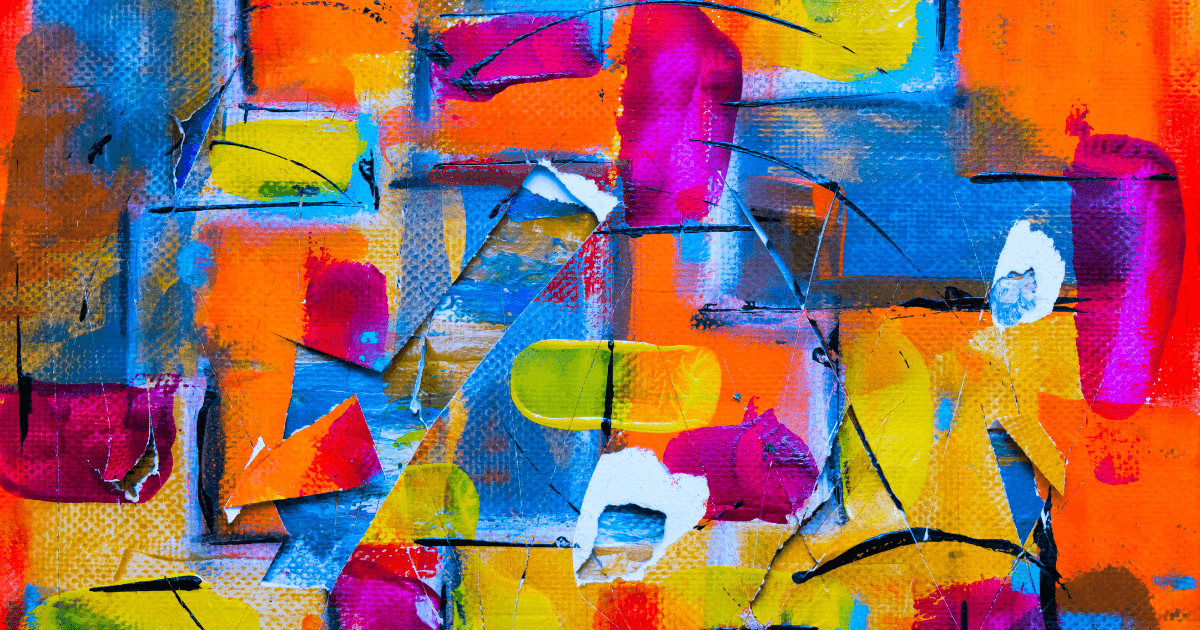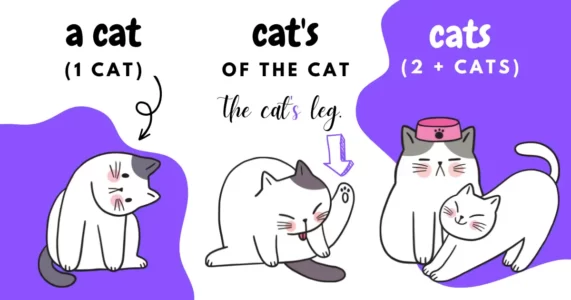“The Big Bad Wolf or How the Order Changes” is an attempt to dive deeper into the topic of what the order of adjectives is in English. There are always exceptions to rules, so it is important to mention a few.
The order of adjectives in English is not written in stone, and many sources offer different orders, but here is what it looks like according to the Farlex Grammar Book Complete English Grammar Rules.
- Adjectives of opinion (nice, good, beautiful, bad)
- Size & measurement adjectives (tall, large, small, big)
- Shape adjectives (round, square, oval)
- Adjectives of condition (dirty, clean, happy, sad)
- Age adjectives (young, old, new, antique)
- Color adjectives (orange, reddish, transparent)
- Adjectives of pattern (polka-dot, checked, striped)
- Adjectives of origin (Spanish, Chinese, German)
- Adjectives of material (wooden, plastic, metallic)
- Adjectives of purpose (shopping bag, rolling pin, kitchen table, passenger seat)
*Sometimes nouns can act as adjectives, too.
Adjectives can be placed either:
- before the word they modify (or describe)
- after it, following the linking verb to be1
- after a sense verb2, which acts as a linking verb.
- That is an interesting story.
- This story is1 interesting.
- This story sounds2 interesting.
Even though most adjectives can be found before or after the word they modify, some can only have a fixed position.
➡️ The hamster is alert and thinking of escape.✅
➡️ Thealerthamster is thinking of escape.❌

Postpositive adjectives (appearing after a noun/ pronoun)
Sometimes, attributive adjectives can come immediately after pronouns or nouns, in a so-called postpositive position ➡️ postpositive adjectives. We do this for several reasons:
- With borrowed words, especially when it comes to legal, financial terms, or military and other administrative positions individuals have
- When used together with superlative adjectives1 with an attributive position.
- With pronouns2.
- Accounts payable represents the amount of money to be paid, whereas accounts receivable represents the amount to be received.
- That was the cheapest1 option available.
- That was the worst1 scenario possible.
- I need someone professional2 to do this task.
- This applies to everyonepresent2.
- The attorney general‘s job is to represent the public’s interest in their state.
Adjectives that end in -able/-ible are often placed in a postpositive position. Switching places may cause differences in meaning.
- Lily is looking for a responsible man.
- Lily is looking for the man responsible.
Both sentences above are correct but mean different things. In the first sentence, Lily is looking for a man she can trust and count on. In the second – for the man who did something wrong.
Types of opinion adjectives
Generally speaking, there are two types of adjectives: opinion adjectives (which we use to express our opinions about something or someone) and fact adjectives that help us learn more (or tell more) about a factual feature someone or something has in terms of size, shape, age, material, etc.
There are two types of opinion adjectives – general opinion 1, andspecific opinion2 adjectives. The first type can be used with a person, an animal, or a thing, while the second is used only with specific nouns.
For example, we can use the adjective beautiful to describe a person, an animal, or an object, but we cannot use the adjective delicious the same way.
Some adjectives can only be used specifically for people and animals (friendly, intelligent, etc.), while others need nouns like furniture, foods, places, etc.
- I live in a beautiful1 town.*
- A comfortable2 bed. **
- A delicious2 sandwich. ***
- A spacious2 apartment. ****
*People, animals, places, things – anything can be beautiful.
**A bed can be comfortable, but it cannot be smart or friendly.
***Food can be delicious, but it cannot be intelligent or comfortable. (Do not mistake it for comfort food – it’s a totally different matter.)
****An apartment can be spacious, but not delicious.
As for the order of these types of adjectives, general opinion adjectives1 come before specific opinion adjectives2.
- David is a nice1, hard-working2 man.
- What alovely1, cozy2 studio!
Adjectives of color

Adjectives of color include the names of colors themselves (black, red, yellow) and approximate colors (reddish, grayish) but also color properties (transparent, opaque, bright).
If we use adjectives of color and color properties in a sentence, the property comes first.
- She wore a bright(color property) yellow(color) dress.
If there is a general opinion adjective1 in the mix, it comes before the property2 and the color adjectives3.
- She wore a lovely1, bright2 yellow3 dress.
If there are two color adjectives, we add and between them.
- He wore a black and white shirt.
Size & measurement adjectives
Usually, adjectives of length1 come before adjectives of width2.
- The car drove down the long1, wide2 road.✅
- The car drove down the wide2, long1 road.❌
Adjectives of purpose
Adjectives of purpose, as already mentioned, help us understand what something is for. Usually, they end in -ing.
- a sleepingbag
- a shoppingcart
- a roastingpan
- a rollingpin
Sometimes a noun may act as an adjective if it precedes another noun and defines it, giving it a specific purpose.
- a passengerseat
- a cupboarddoor
- a kitchentable
About commas and adjectives: how to decide when to add a comma?

When it comes to commas, the rule of thumb is this: if you have a sentence with multiple adjectives, and each adjective can stand independently of the others in a separate sentence with the noun, then put commas between said adjectives. Such adjectives are called coordinate adjectives.
Adjectives that need each other to paint the whole picture are called cumulative adjectives; we do not separate them with a comma.
There are three ways to determine whether adjectives are coordinate (and should be separated by a comma) or cumulative (and shouldn’t.)
- Check if the adjectives can describe the noun independently of each other
- Switch their places and see if the sentence still makes sense
- Add and in between and check if the sentence continues to make sense
If all of the above works, then add a comma. If it doesn’t – we are talking about cumulative adjectives, so no comma is needed.
Test number 1
Let’s check! Take the example sentence There is a lovely, small shop downtown.
- Independence check:
- There is a lovely shop downtown. ✅
- There is a small shop downtown. ✅
- Switch places:
- There is a small lovely store downtown. ✅
- Add and:
- There is a lovely and small shop downtown. ✅
Although technically speaking, the sentences above are not 100% grammatically correct, they are still ok, so it is safe to say that we need a comma between the adjectives lovely and small:
- There is a lovely, small shop downtown.
Test number 2
Let’s have a look at another example:
I bought this pink leather purse from the lovely, small shop downtown.
We already checked and saw that there should be a comma between the opinion adjective lovely and the size adjective small.
Now let’s see if there should be a comma between the color adjective pink and the adjective of material leather.
- Independence check:
- I bought this pink purse. ✅
- I bought this leather purse. ✅
- Switch places:
- I bought this leather pink purse. ❌
- Add and:
- I bought this pink and leather purse. ❌
In the case of the pink leather purse, the adjectives pink and leather are cumulative because they build on each other to make a full description. The purse is not only leather, but the leather is also pink, so the adjective pink builds on the description of the leather purse as a whole, and we cannot separate them with a comma.
Different sources, different categories
As mentioned above, the order of adjectives presented here is based on the Farlex Grammar Book Complete English Grammar Rules. Other sources include another category of adjectives called physical quality in the third position after size and before shape adjectives (for example, here). This category seems quite broad, and – among others – it includes adjectives that would fall under the condition category from this infographic. (For example, untidy).
How the order changes
The Big Bad Wolf

The very name of the Big Bad Wolf illustrates how something can break the rules and yet sound so natural that we wouldn’t have it any other way.
If we were to switch the places of the adjectives big and bad to fit the rule of opinion first, and facts second (Bad, Big Woolf), the character most of us know but can’t say we love will be completely destroyed. 🐺
The article in the Washinton Post “Big, bad wolf or bad, big wolf? The surprising way we order our words.” offers the following explanation:
The “big bad wolf” of fairy tale, for instance, shows the size adjective preceding the opinion one. Examples such as these are instead witness to the “Pollyanna Principle,” by which speakers prefer to present positive, or indifferent, values before negative ones.
“Big, bad wolf or bad, big wolf? The surprising way we order our words.“, Simon Horobin, the Washinton Post
There is another interesting explanation for this, found in an article from BBC that mentions the enigmatic linguistic rule of ablaut reduplication / ˈæblaʊt rɪˌdjuːplɪˈkeɪʃən /. It may sound like something you have never heard before, but it is present in the daily lives of most (if not all) active users of the English language today, especially if they are on TikTok.
For sanity’s sake, let’s call it the I, A, O rule.🙏
Reduplication in linguistics is when you repeat a word, sometimes with an altered consonant (lovey-dovey, fuddy-duddy, nitty-gritty), and sometimes with an altered vowel: bish-bash-bosh, ding-dang-dong. If there are three words then the order has to go I, A, O. If there are two words then the first is I and the second is either A or O.
“The language rules we know – but don’t know we know“, Mark Forsyth, BBC
Some other examples include zig-zag, tick-tack, King Kong, etc.
Beautiful, big vs. big, beautiful
Even though, as mentioned before, opinion adjectives normally come first, in the combination of beautiful, and big there was a shift that happened around 1960, and the adjectives beautiful(opinion adjective) and big(size adjective) changed places. The Ngram from Google below shows that now the order big, beautiful is more frequently used.
Click here if the chart doesn’t display.
As the data from Google shows, until 1960 beautiful, big was more frequently used, but it changed and the reversed order has been used consistently since then.
This may be due to wanting to put the emphasis on big instead of beautiful. (Perhaps the American Dream has a lot to do with that 😁.) Also, when it comes to the subject of lifestyle, many people have different opinions on what a big house or a big car looks like, so this order is not surprising.
Small, however, is small. 😀
Click here if the chart doesn’t display.
Old round vs. round old
Although shape adjectives precede age adjectives, as shown in this infographic inspired by the Farlex Grammar Book “Complete English Grammar Rules“, and also in the Cambridge Dictionary), some sources put age adjectives before shape adjectives.
Here is another Ngram which shows that the age adjective old comes before the shape adjective round, and that order is more commonly used.
Click here if the chart doesn’t display.
Of course, that is not always the case as another example illustrates:
- I found a straight (shape), vintage (age) dress at the thrift store that perfectly captures the timeless elegance of the 1950s.


